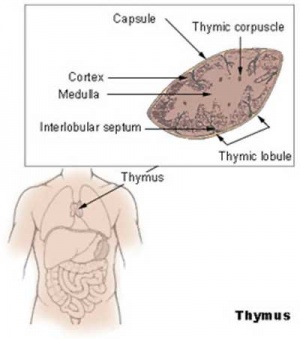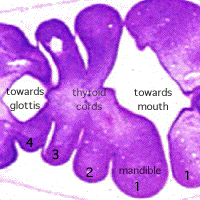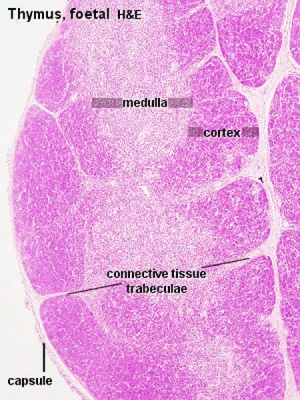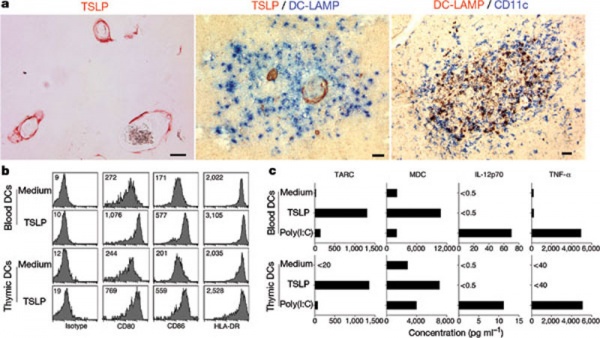Thymus Development: Difference between revisions
| Line 110: | Line 110: | ||
==Hassall's Bodies== | ==Hassall's Bodies== | ||
[[File:Thymus - young 01.jpg|thumb|Fetal thymus showing Hassall's body]] | [[File:Thymus - young 01.jpg|thumb|Fetal thymus showing Hassall's body]] | ||
Hassall's bodies, also called Hassall's corpuscles | Hassall's bodies, also called Hassall's corpuscles | ||
* form between 6 and 10 lunar months in humans. | * form between 6 and 10 lunar months in humans. | ||
* appear after lymphopoiesis has been established and the cortex, medulla and the cortico-medullary junction are able to select of T lymphocytes undergoing progressive maturation. | * appear after lymphopoiesis has been established and the cortex, medulla and the cortico-medullary junction are able to select of T lymphocytes undergoing progressive maturation. | ||
* within the thymus their number increases until puberty, then decreases. | * within the thymus their number increases until puberty, then decreases. | ||
* features are named after Arthur Hill Hassall (1817-1894) a British physician and chemist. | * features are named after [[:File:Arthur Hill Hassall.jpg|Arthur Hill Hassall|Arthur Hill Hassall]] (1817-1894) a British physician and chemist. | ||
===Function=== | ===Function=== | ||
Revision as of 14:08, 20 February 2012
Introduction
The thymus has a key role in the development of an effective immune system as well as an endocrine function.
The thymus has two origins for the lymphoid thymocytes and the thymic epithelial cells. The thymic epithelium begins as two flask-shape endodermal diverticula that form from the third pharyngeal pouch and extend lateralward and backward into the surrounding mesoderm and neural crest-derived mesenchyme in front of the ventral aorta. The immune system T cells are essential for responses against infections and much research concerns the postnatal development of T cells within the thymus.
The mature thymus epithelium has two main cell types: cortical thymic epithelial (cTECs) and medullary thymic epithelial cells (mTECs) or stromal cells. These thymic stromal cells provide signals for T cell differentiation.
| Immune Links: immune | blood | spleen | thymus | lymphatic | lymph node | Antibody | Med Lecture - Lymphatic Structure | Med Practical | Immune Movies | vaccination | bacterial infection | Abnormalities | Category:Immune | ||
|
Some Recent Findings
|
Recent References | References
Development Overview
The thymus and parathyroid are derived from 3rd pharyngeal pouches.
Development is a series of epithelial/mesenchymal inductive interactions between neural crest-derived arch mesenchyme and pouch endoderm. There is also the possibility that the surface ectoderm of 3rd pharyngeal clefts participates in thymus development.
Thymic epithelial cells (TECs) are derived from the endoderm of the third pharyngeal pouch.
Hassall's bodies form between 6 and 10 lunar months in humans. They appear after lymphopoiesis has been established and the cortex, medulla and the cortico-medullary junction are able to select of T lymphocytes undergoing progressive maturation. (Text modified from Bodey and Kaiser, 1997)
Experimental studies have shown that a neural crest contribution is also required during early thymic organogenesis.
MBoC Figure 24-6. The development and activation of T and B cells
Figure 24-7. Electron micrographs of nonactivated and activated lymphocytes
Week 8
Late embryonic thymus development.
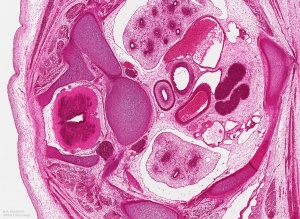
|
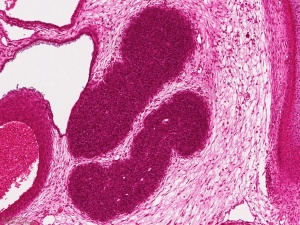
|
| Image shows general position of the developing thymus in entire embryo cross-section. The developing thymus is shown in the midline, located behind the sternum (right) and in front of the oesophagus and trachea. | Selected high power image of thymus from complete cross-section above. |
- Links: Carnegie stage 22
Development Changes
Changes with age Overall Size
- birth 10-15 g
- puberty 30-40 g
- after puberty - involution
- Replaced by adipose tissue
- middle-aged 10 g
Thymus Anatomy
- Superior mediastinum, anterior to heart
- Bilobed lymphoepithelial organ
- Contains reticular cells but no fibers
- Stem lymphocytes
- proliferate and differentiate
- forms long-lived T- lymphocytes
Thymus Cells
- Reticular cells
- Abundant, eosinophilic, large, ovoid and light nucleus 1-2 nucleoli
- sheathe cortical capillaries
- form an epitheloid layer
- maintain microenvironment for development of T-lymphocytes in cortex (thymic epitheliocytes)
- Macrophages
- cortex and medulla
- difficult to distinguish from reticular cells in H&E
- Lymphocytes
- cortex and medulla - more numerous (denser) in cortex
- majority of them developing T-lymphocytes (= thymic lymphocytes or thymocytes)
Fetal/Young Thymus
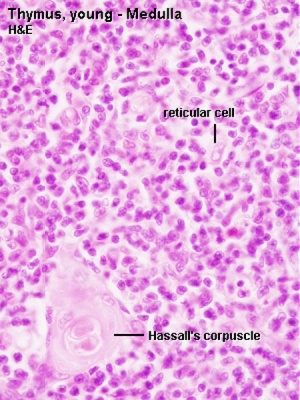
|

|
| Young medulla | Young cortex |
Thymic corpuscle
Hassall’s corpuscle - Mass of concentric epithelioreticular cells
Thymus Involution
A postnatal process defined as a decrease in the size, weight and activity of the gland with advancing age. In a recent review[3], thymic involution was described as a result of high levels of circulating sex hormones, in particular during puberty, and a lower population of precursor cells from the bone marrow and finally changes in the thymic microenvironment.
- Cortical lymphoid tissue is replaced by adipose tissue
- Increase in size of thymic corpuscles
Links: Blue Histology - Thymus
Hassall's Bodies
Hassall's bodies, also called Hassall's corpuscles
- form between 6 and 10 lunar months in humans.
- appear after lymphopoiesis has been established and the cortex, medulla and the cortico-medullary junction are able to select of T lymphocytes undergoing progressive maturation.
- within the thymus their number increases until puberty, then decreases.
- features are named after Arthur Hill Hassall|Arthur Hill Hassall (1817-1894) a British physician and chemist.
Function
Hassall's corpuscles express thymic stromal lymphopoietin (TSLP), suggesting that Hassall's corpuscles have a critical role in dendritic-cell-mediated secondary positive selection of medium-to-high affinity self-reactive T cells, leading to the generation of CD4(+)CD25(+) regulatory T cells within the thymus.[4]
Thymic stromal lymphopoietin is an epithelial cell-derived cytokine expressed in several tissues (skin, gut, lungs, and thymus) that signals through a TSLP receptor (TSLPR). This receptor is a heterodimer of the IL-7 receptor alpha chain and the TSLPR chain.
Disease Association
There has been one report showing changes in Hassall's bodies morphology associated with congenital heart defects.[5]
Molecular Development
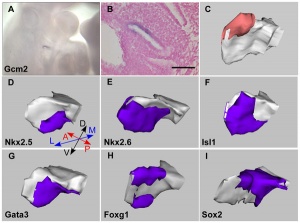
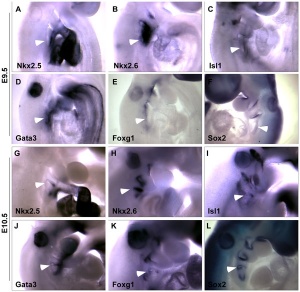

Foxg1 and Isl1
Transcription factors that appear to have a role in early thymic epithelial cell (TEC) differentiation
Foxn1
Cited2
Cited2 deletion in the mouse is embryonic lethal with cardiovascular malformations, adrenal agenesis, cranial ganglia fusion, exencephaly, and left-right patterning defects.[7]
- "Examination of Lmo4-deficient embryos revealed partially penetrant cardiovascular malformations and hypoplastic thymus. Examination of Lmo4;Cited2 compound mutants indicated that there is a genetic interaction between Cited2 and Lmo4 in control of thymus development. Our data suggest that this may occur, in part, through control of expression of a common target gene, Tbx1, which is necessary for normal thymus development."
Eva and Six
Both Eva and Six have been implicated in thymus development.[8]
- Eya - human homolog of the Drosophila 'eyes absent' (Eya) gene.
- Six - vertebrate genes which are homologs of the Drosophila 'sine oculis' (so) gene.
References
Reviews
<pubmed>18403191</pubmed> <pubmed>16846255</pubmed> <pubmed>16448532</pubmed> <pubmed>12969307</pubmed> <pubmed>11292256</pubmed>
Articles
<pubmed>11857615</pubmed>
Search PubMed: Thymus Development | Thymus Embryology
Glossary Links
- Glossary: A | B | C | D | E | F | G | H | I | J | K | L | M | N | O | P | Q | R | S | T | U | V | W | X | Y | Z | Numbers | Symbols | Term Link
Cite this page: Hill, M.A. (2024, April 18) Embryology Thymus Development. Retrieved from https://embryology.med.unsw.edu.au/embryology/index.php/Thymus_Development
- © Dr Mark Hill 2024, UNSW Embryology ISBN: 978 0 7334 2609 4 - UNSW CRICOS Provider Code No. 00098G
